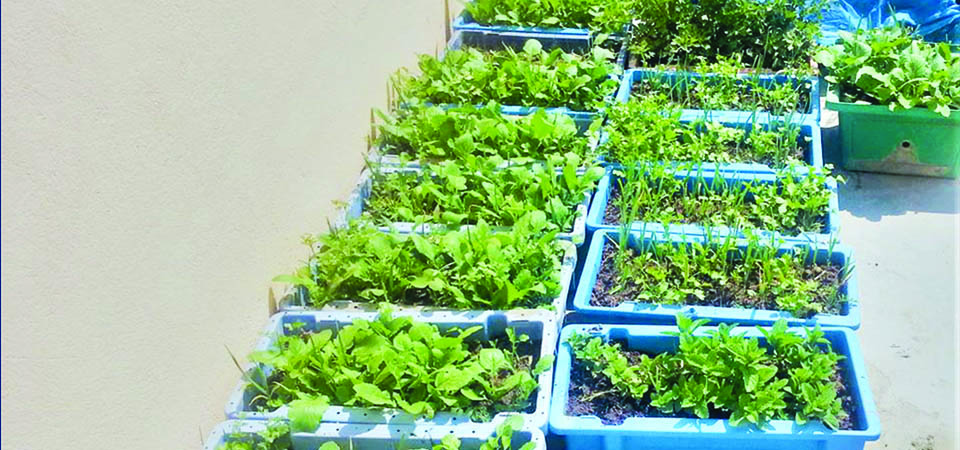Segregation, composting key to manage Kathmandu’s waste

By Shaurya Kshatri
Kathmandu, Jan. 24: Signs of life sprouting out of vegetable trays on Sanu Maiya Maharjan’s humble terrace garden can be fascinating for some. She has grown chillies, eggplants, beans, big bulky lemons, and earthy red radishes in rice sacks, and cardboard boxes without using any chemical fertilisers whatsoever. Maharjan, a Waste Management Expert at the Department of Environment, Kathmandu Metropolitan City (KMC), has breathed life into kitchen leftovers.
She is careful not to mix wet food wastes such as bones, tea bags, eggshells with plastic garbage such as packets of chips, sanitary pads, and milk pouches. The key to waste management, she says, is segregating inorganic from organic wastes.
For the last 24 years, Maharjan has been advocating for the need to convert wastes into composts or to at least separate recyclable and non-recyclable wastes in separate bins. “The process is really simple. Even if there isn’t a compost bin, making one is quite easy,” she suggests. “Just drill about five holes around a bucket at different levels to let some air in. To avoid any spill, place a newspaper underneath your container and layer the bottom with soil,” she informs.
The segregated kitchen waste is then poured into the container and within a month or two the waste will decompose into compost, which can be used in the kitchen or terrace garden.
However, much to the chagrin of environmentalists and hardworking waste collectors, segregation is extremely rare.
This constitutes the crux of solid waste management problem in Kathmandu.
Kathmandu Valley generates around 1,000 metric tonnes of garbage per day. Every day, hundreds of lorries carry organic waste to Sisdole in adjacent Nuwakot district, which is already running out of its capacity. Started as a short-term landfill site back in 2005, Sisdole has become a permanent dumping area for all of Kathmandu.
With Sisdole already overburdened, the government had initiated plans to develop Banchare Danda (also in Nuwakot) as a long-term landfill site back in 2009, which is estimated to finally come into operation within the end of this Nepali year.
However, Waste Management Experts like Nabin Bikash Maharjan don’t believe in an additional landfill site to lift the burden off the Capital’s increasing waste generation. For him, the solution is quite simple: waste segregation and composting.
Hari Kumar Shrestha, head of the Environment Department at KMC, also holds similar views. According to him, 60 per cent of the organic waste originating in the Valley can be converted into compost manure. Of the remaining 40 percent, 30 percent of non-biodegradable waste can be sold to recyclers. “If this happens, only the remaining 10 per cent waste goes to the dumping site, and we can easily cope with the chronic solid waste problem of our city,” said Shrestha.
Since many don’t realise the value of the trash , thousands of rag pickers at scrap stations owned by private and public waste management organisations, spend countless hours separating the organic wastes from the inorganic ones to sell them as manure and compost. One company, Biocomp Nepal, collects over 20 tonnes of municipal organic waste, particularly from vegetable wholesalers at Kalimati and Blakhu market, turning it into profits by selling organic fertilisers to farmers.
Burying organic waste in landfill is a big problem in Kathmandu, as Maharjan, who operates Kirtipur Waste Management Service, elucidates: “When organic waste is dumped in landfill, it undergoes anaerobic decomposition and generates methane. When released into the atmosphere, methane is 25 times more potent greenhouse gas than carbon dioxide.”
But a lot of organic waste ends up in Sisdole. According to a report published by the United Nations Environment Programme, 2019, greenhouse gases are emitted from leachate at the Sisdole landfill site.
To stop organic wastes from ending up at landfill sites, the government has taken several initiatives, but to no avail. In 2019, KMC launched an initiative segregating biodegradable and non-biodegradable household wastes from the source by collecting organic wastes only on one day and inorganic waste another day.
Moreover, Solid Waste Management Act 2011, specifically states that those who dispose of waste without segregating biodegradable and non-biodegradable waste are liable to a fine of Rs. 500. Regardless of such initiatives, waste segregation and management continues to be blatantly disregarded. As per the Environment Statistics of Nepal 2019 released by the Central Bureau of Statistics, 89.3 per cent of industries don’t have solid waste management facilities.
The onus of managing one’s garbage thus lies on each and every one of us and not just the government. The solutions are known -- waste segregation and composting. What is lacking is their effective implementation.
Recent News

Do not make expressions casting dout on election: EC
14 Apr, 2022
CM Bhatta says may New Year 2079 BS inspire positive thinking
14 Apr, 2022
Three new cases, 44 recoveries in 24 hours
14 Apr, 2022
689 climbers of 84 teams so far acquire permits for climbing various peaks this spring season
14 Apr, 2022
How the rising cost of living crisis is impacting Nepal
14 Apr, 2022
US military confirms an interstellar meteor collided with Earth
14 Apr, 2022
Valneva Covid vaccine approved for use in UK
14 Apr, 2022
Chair Prachanda highlights need of unity among Maoist, Communist forces
14 Apr, 2022
Ranbir Kapoor and Alia Bhatt: Bollywood toasts star couple on wedding
14 Apr, 2022
President Bhandari confers decorations (Photo Feature)
14 Apr, 2022










